How to keep up your yard care with double brood cicadas out
Fun fact: Cicadas love lawn mowers
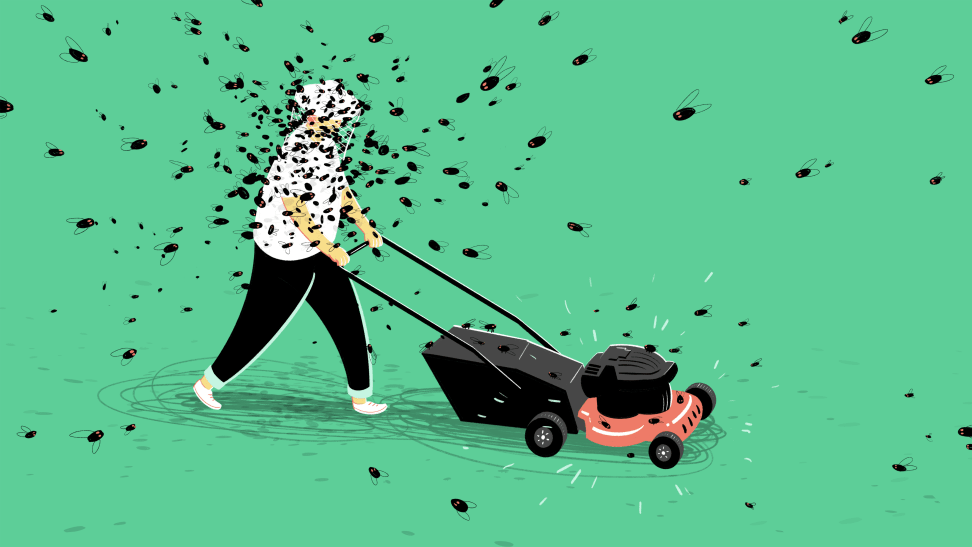 Credit:
Reviewed / Tara Jacoby
Credit:
Reviewed / Tara Jacoby
Products are chosen independently by our editors. Purchases made through our links may earn us a commission.
Double brood cicadas—two breeds of periodical cicadas—are now emerging across several states in the Eastern U.S. After 17- and 13-year stints underground, billions of cicadas have risen up (quite literally) and started their mating journey.
You may have already noticed their presence, as these swarms of cicadas are loud. However, in addition to the noise, residents in affected states will notice that cicadas come out in large numbers—they'll be all over the yard. With so many bugs around, you might wonder how to care for your lawn and plants without being swarmed.
Luckily, cicadas are generally harmless to humans and animals. Still, with so many cicadas out there, you'll have to work around this natural phenomenon when it comes to your lawn maintenance routine. Here’s how to keep up your landscaping during the emergence of cicadas in 2024.
Mow your lawn at the right hours

Cicadas may gravitate towards you if you're using a loud, buzzy tool like a lawn mower—but they won't bite or harm you in any way.
If you live in a potentially impacted area, it’s possible that you’ll soon witness (if you haven't already) swarms upon swarms of cicadas in your town and neighborhood. As they spend their weeks above ground, the males will make loud buzzing noises in an attempt to attract a female mate.
Because of this, cicadas love hearing that loud buzz back, and often mistake human-made sounds as a fellow mate.
Lawnmowers, hedge trimmers, leaf blowers, and other loud and vibrating machinery will attract cicadas toward your yard. And while these incoming insects are generally harmless, they can feel overwhelming.
For this reason, Josh Matta, senior biologist at Spectracide, recommends adjusting your lawn care activities accordingly. “Plan to perform yard maintenance in the early morning or at dusk when it’s cooler and cicadas are less active to avoid swarming,” says Matta.
For extra protection, while mowing your lawn, you can even wear something like this pop-up mesh pod to protect your face and upper body from contact with those persistent cicadas.
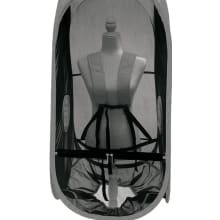
This personal bug net keeps out cicadas, mosquitoes, or black flies.
Cover your trees, bushes, and flowers
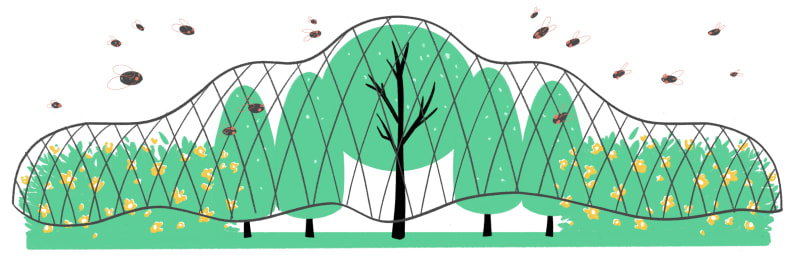
Garden netting should fit securely on the tree, but not too tight. Make sure the branches are still in their natural position with the netting on.
Here’s the good news: When cicadas emerge from the ground, they won’t return to it. They may leave behind cicada emergence holes, which are about a half-inch wide and 3 inches deep, but don’t worry—these won’t damage your lawn in the long run.
While cicadas don’t cause much damage to trees and plants, they can still cause some trouble.
The main concern for your yard is when the insects begin to lay their eggs up in the trees. While more mature trees can handle this, the smaller, weaker, or younger trees may experience some damage as eggs stay put until they eventually hatch approximately four to six weeks later.
Nicholas Martin, entomologist and founder of Pest Control Hacks, says you can cover up your smaller trees or saplings with a physical barrier like a garden net to protect them from cicada eggs and the flying chaos in general. Make sure it is properly secured around the trunk of the tree, ensuring no insect can fly its way up from the base.

A garden net keeps cicadas away from your shrubs and vegetables.
Put off new plantings
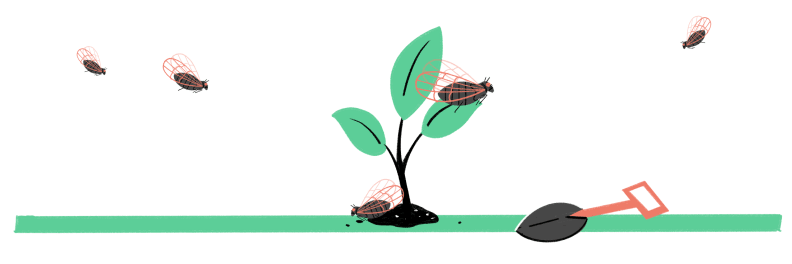
Cicadas will make tiny slits in tree branches in order to lay their eggs. This won't damage most trees at all, but it may snap some branches on younger, weaker trees.
Since these insects can potentially damage young trees, experts recommend avoiding planting any new trees before or during the emergence of the cicadas.
This also goes for transplanting any small saplings—Raupp tells USA TODAY that you should wait until the fall to avoid any run-ins with cicadas and their eggs.
Avoid using pesticides
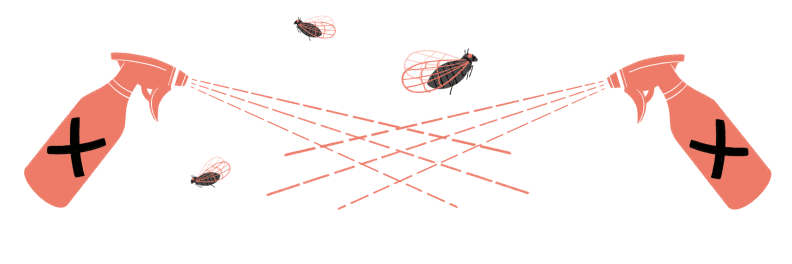
Save your money and time and avoid any attempt at insect control, as your efforts against the trillions of cicadas will most likely be futile.
You may be tempted to try to eliminate these loud bugs, whether by using a pesticide or with other pest control methods. However, Martin says there isn’t much use in doing so as you may end up having to clean up dead cicada bodies from your yard. Not ideal.
Let’s remember the sheer amount of cicadas we’re dealing with—trillions—so prevention and management of these insects isn’t a viable option.
As was true in previous years, the use of pesticides could end up being more harmful to other species of insects. If the cicadas in your area are out of control, and it’s difficult to go outside, you may just want to limit your outdoor activities to dawn and dusk hours rather than trying to fight back.
While all this insect noise may feel overwhelming, it’s not going to last for too long. Their lifespan is only four to six weeks, and they are expected to start to die off in late June and July.
How to clean up after the double brood cicadas
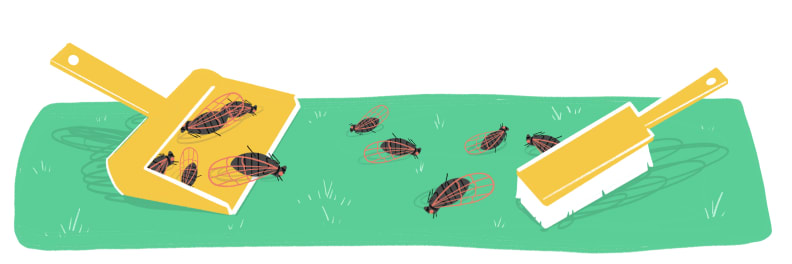
To help collect deceased cicadas, you may want to use a shovel, rake, or similar tool to help gather them into piles.
Unfortunately, you may run into some dead cicadas in or around your yard at some point. There is no harm in letting them decompose in your yard—they may even benefit your plants as they begin to emit nitrogen into the soil.
However, if you want to avoid unsightly insect bodies littering your landscaping and making a stench, it’s best to clean them up as quickly as possible.
Matta says, “Depending on the amount of dead cicadas, you may have to use a dustpan and broom or a snow shovel for larger amounts.”
Begin to shovel up the dead cicadas that have fallen into your yard. You may also need to check your gutters and clear out any deceased insects there as well.
From there, Matta recommends burying the dead cicadas in a deep hole if possible. If you’re unable to dig a hole in your yard, you can collect them and add them to your outside garbage bin for pickup. You can even add the dead cicadas to your compost, if you’d like.
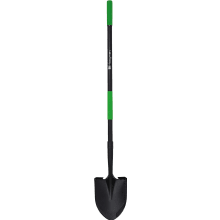
Cicadas are good for your garden if you bury them.
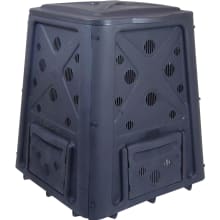
Compost cicada bodies with our favorite compost bin and end up with some nitrogen-rich mulch.



